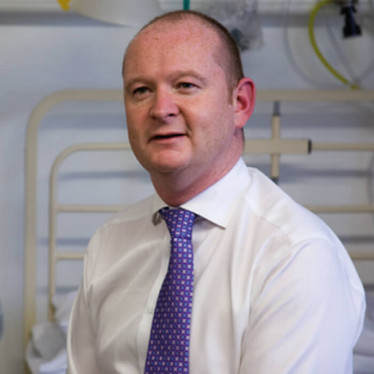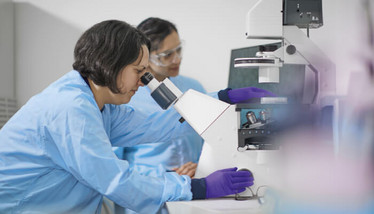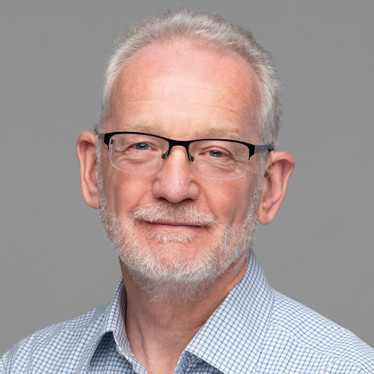
A Framework for Translation
Even the most promising research cannot benefit patients unless it can be guided down a successful pathway towards the clinic. Here, Andrew Davies, Professor of Haematological Oncology and Consultant Medical Oncologist at the University of Southampton, and Nigel Blackburn, Cancer Research UK’s Director of Drug Development, discuss a partnership that focuses on one crucial aspect of that journey: early-phase clinical trials.

The translational journey, with Andrew Davies
Over the years, I’ve been involved in many aspects of early-stage and clinical research. My focus is on malignant lymphoma and the translation of novel therapies and relevant biomarkers into the clinic. To that end, I am the principal investigator on a number of early-phase clinical studies.
At the University of Southampton, we’ve been conducting preclinical research into monoclonal antibody (mAb)-based cancer therapies for many years; in fact, the group has made several seminal observations in this field (1, 2, 3, 4). Given our expertise, we were approached by a company called BioInvent, which has developed an mAb targeting the inhibitory FcγRIIB (CD32B) – a mediator of several immunotherapy resistance mechanisms. The mAb showed significant promise in preclinical studies, and so we worked together with BioInvent to submit a research proposal to the Centre for Drug Development (CDD) at Cancer Research UK; in brief, we had to explain the existing data and the rationale for taking the work further – including unmet patient need.

Now, working with the CDD, we have beenable to generate the additional data required to open the clinical trial – as well as the capability and support to run a first-in-human (FIH) study. We really believe the CDD’s significant experience in trial design, management, and strategy will help us deliver a successful project.
After we’ve defined the optimal dose of our single agent, which should not take too much longer, we will assess BioInvent’s mAb in combination with rituximab (an anti-CD20 mAb). We hope we will see enhanced rituximab efficacy, given that blocking the CD32b receptor should prevent internalization of rituximab. We’re really looking forward to moving onto that phase of the study. After all, if we can improve outcomes in those patients, it should open the door for us to assess this mAb in combination with a number of other agents; for example, immunomodulatory agents and chemotherapeutics. We have a lot of potential avenues to explore – it’s an exciting time!
In terms of novel agents in blood cancers, there are exciting things coming from all directions. There is keen interest in the development of cellular therapies – chimeric antigen receptor T (CAR-T) cells and NK cells, which have tumor-targeting effects. We are now beginning to see the use of these in clinical practice. There are also exciting developmental lines in both solid and hematological malignancies, I think we will continue to see refinements in cellular therapies – despite complications in how they are delivered.
Among all these advances though, I remain particularly interested in the development of novel bi-specific antibodies that can not only engage the target antigen but also activate T cells. There are already results that demonstrate the efficacy of these agents (5) – and I believe such antibodies represent a more “off-the-shelf” solution than cellular therapies.
From an oncologist’s perspective, we want to get much better at stratifying patients, so that we can take a more targeted approach to treatment. And so it’s really exciting to be part of a research community that is moving towards this dream of delivering personalized therapies – all while enhancing our understanding of the biology of the disease we are treating.

The power of partnership, with Nigel Blackburn
As Director of Drug Development at Cancer Research UK, I oversee CDD, which has around 20 ongoing projects at various stages of development in its portfolio. What the CDD really brings to the table is a knowledge of how to take a potential new medicine from preclinical research through to Phase 2a clinical trials. We work with drug discovery scientists and chief investigators to collectively bring a molecule through FIH trials. Essentially, it is a partnership of complementary expertise.
In the example described by Andrew, we have also partnered with Bloodwise (the UK’s leading blood cancer research charity) from a funding perspective. If the molecule makes it to market, both Cancer Research UK and Bloodwise will use any financial return to fund further research – the start of a virtuous cycle.
The work with BioInvent fits into a framework that we call a Clinical Development Partnership – something we employ for most of our pharma and biotech partners. In brief, we take a project – based on the partner’s assets – through to proof of mechanism. At that point, the originating company has the opportunity to explore the data. If they like what they see, they can license it from us, and move the project onto the next stage themselves. We receive milestone payments as the project then moves through later development and marketing.
We’ve been involved in over 20 projects using this framework. For example, we’ve been working with a German biotech company, called Immatics, who exercised their option and have taken the molecule back in-house. There are several other companies who have done the same with molecules such as temozolomide (a mainstay of glioblastoma treatment) and Abiraterone (a prostate cancer treatment). Another example is Rucaparib (Rubraca) – a PARP inhibitor that was formulated and taken into human trials by the CDD.
The “dream” identified by Andrew fits beautifully with our efforts at the CDD. We are always on the lookout for potential new treatments. And when seeking innovation, first and foremost we are looking for patient benefit.
I’d like to close with an invitation: we’re always happy to meet with both academics and biotech companies to discuss how we can work together.
Find out more here
- RR French et al., “CD40 antibody evokes a cytotoxic T-cell response that eradicates lymphoma and bypasses T-cell help”, Nat Med, 5, 548 (1999). DOI: 10.1038/8426
- MS Cragg et al., “Complement-mediated lysis by anti-CD20 mAb correlates with segregation into lipid rafts”, Blood, 101, 1045 (2003). DOI: 10.1182/blood-2002-06-1761
- R Offringa, MJ Glennie, “Development of next-generation immunomodulatory antibodies for cancer therapy through optimization of the IgG framework”, Cancer Cell,28, 273 (2015). DOI: 10.1016/j.ccell.2015.08.008
- A Roghanian et al., “Antagonistic human FcγRIIB (CD32B) antibodies have anti-tumor activity and overcome resistance to antibody therapy in vivo”, Cancer Cell, 27, 473 (2015). DOI: 10.1016/j.ccell.2015.03.005
- LE Budde et al., “Mosunetuzumab, a full-length bispecific CD20/CD3 antibody, displays clinical activity in relapsed/refractory B-cell non-Hodgkin lymphoma (NHL): interim safety and efficacy results from a Phase 1 Study”, Blood, 132 (Supplement 1): 399 (2018). DOI: 10.1182/blood-2018-99-118344
















